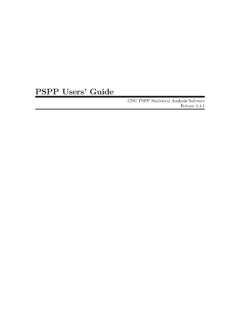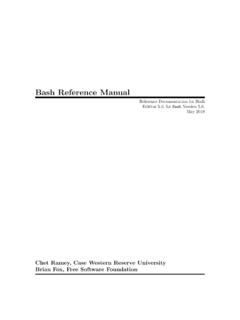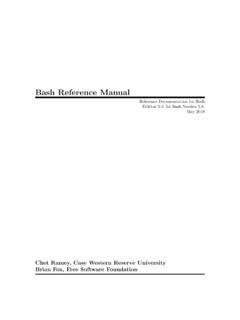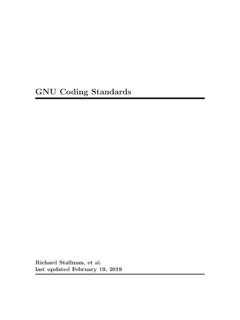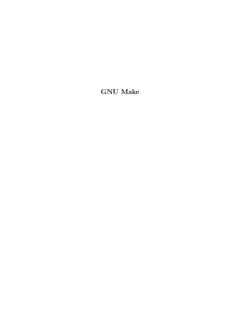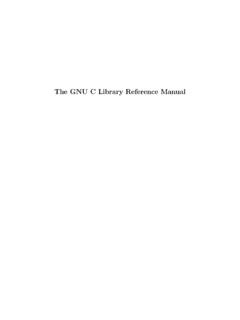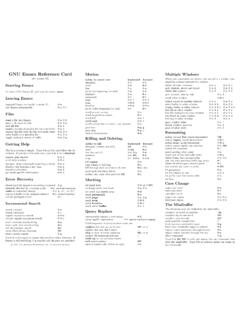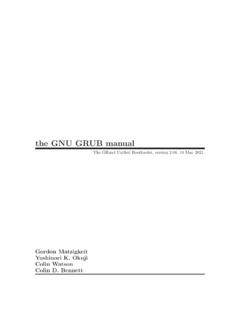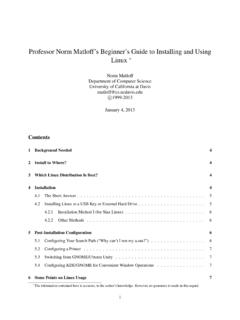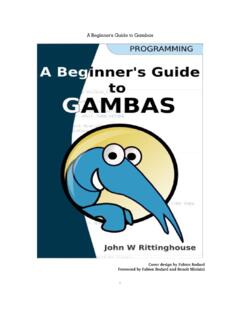Transcription of GNU sed, a stream editor
1 gnu sed , a stream editor version , 30 March 2018. by Ken Pizzini, Paolo Bonzini This file documents version of gnu sed , a stream editor . Copyright c 1998-2018 Free Software Foundation, Inc. Permission is granted to copy, distribute and/or modify this document under the terms of the GNU Free Documentation License, Version or any later version published by the Free Software Foundation; with no Invariant Sections, no Front-Cover Texts, and no Back-Cover Texts. A copy of the license is included in the section entitled GNU Free Documentation License . i Table of Contents 1 Introduction .. 1. 2 Running sed .. 1. Overview .. 1. Command-Line Options .. 2. Exit status .. 5. 3 sed scripts .. 5. sed script overview .. 5. sed commands summary.. 6. The s Command .. 8. Often-Used Commands .. 10. Less Frequently-Used Commands .. 11. Commands for sed gurus .. 16. Commands Specific to gnu sed .. 16. Multiple commands syntax.
2 18. Commands Requiring a newline .. 19. 4 Addresses: selecting lines.. 21. Addresses overview .. 21. Selecting lines by numbers .. 21. selecting lines by text matching .. 22. Range Addresses .. 24. 5 Regular Expressions: selecting text .. 25. Overview of regular expression in sed .. 25. Basic (BRE) and extended (ERE) regular expression .. 26. Overview of basic regular expression syntax .. 26. Overview of extended regular expression syntax .. 28. Character Classes and Bracket Expressions .. 29. regular expression extensions .. 31. Back-references and Subexpressions .. 32. Escape Sequences - specifying special characters.. 33. Escaping Precedence .. 34. Multibyte characters and Locale Considerations .. 34. Invalid multibyte characters.. 35. Upper/Lower case conversion .. 36. Multibyte regexp character classes .. 36. ii 6 Advanced sed: cycles and buffers .. 37. How sed Works .. 37. Hold and Pattern Buffers .. 37.
3 Multiline techniques - using D,G,H,N,P to process multiple lines .. 37. Branching and Flow Control .. 39. Branching and Cycles .. 40. Branching example: joining lines .. 42. 7 Some Sample Scripts.. 43. Joining lines .. 43. Centering Lines .. 44. Increment a Number.. 45. Rename Files to Lower Case .. 46. Print bash Environment .. 48. Reverse Characters of Lines.. 49. Text search across multiple lines .. 49. Line length adjustment .. 51. Reverse Lines of Files.. 52. Numbering Lines .. 53. Numbering Non-blank Lines .. 54. Counting Characters .. 55. Counting Words .. 56. Counting Lines .. 57. Printing the First Lines .. 58. Printing the Last Lines .. 58. Make Duplicate Lines Unique .. 58. Print Duplicated Lines of Input .. 59. Remove All Duplicated Lines .. 60. Squeezing Blank Lines .. 60. 8 gnu sed 's Limitations and Non-limitations .. 62. 9 Other Resources for Learning About sed .. 62. 10 Reporting Bugs .. 63. Appendix A GNU Free Documentation License.
4 66. Concept Index .. 74. Command and Option Index .. 78. 1. 1 Introduction sed is a stream editor . a stream editor is used to perform basic text transformations on an input stream (a file or input from a pipeline). While in some ways similar to an editor which permits scripted edits (such as ed), sed works by making only one pass over the input(s), and is consequently more efficient. But it is sed's ability to filter text in a pipeline which particularly distinguishes it from other types of editors. 2 Running sed This chapter covers how to run sed. Details of sed scripts and individual sed commands are discussed in the next chapter. Overview Normally sed is invoked like this: sed SCRIPT For example, to replace all occurrences of hello' to world' in the file : sed 's/hello/world/' > If you do not specify INPUTFILE, or if INPUTFILE is -, sed filters the contents of the standard input. The following commands are equivalent: sed 's/hello/world/' > sed 's/hello/world/' < > cat | sed 's/hello/world/' - > sed writes output to standard output.
5 Use -i to edit files in-place instead of printing to standard output. See also the W and s///w commands for writing output to other files. The following command modifies and does not produce any output: sed -i 's/hello/world/' By default sed prints all processed input (except input that has been modified/deleted by commands such as d). Use -n to suppress output, and the p command to print specific lines. The following command prints only line 45 of the input file: sed -n '45p' sed treats multiple input files as one long stream . The following example prints the first line of the first file ( ) and the last line of the last file ( ). Use -s to reverse this behavior. sed -n '1p ; $p' Without -e or -f options, sed uses the first non-option parameter as the script, and the following non-option parameters as input files. If -e or -f options are used to specify a script, all non-option parameters are taken as input files.
6 Options -e and -f can be combined, and can appear multiple times (in which case the final effective script will be concatenation of all the individual scripts). The following examples are equivalent: sed 's/hello/world/' > Chapter 2: Running sed 2. sed -e 's/hello/world/' > sed --expression='s/hello/world/' > echo 's/hello/world/' > sed -f > sed --file= > Command-Line Options The full format for invoking sed is: sed [SCRIPT] [ ]. sed may be invoked with the following command-line options: --version Print out the version of sed that is being run and a copyright notice, then exit. --help Print a usage message briefly summarizing these command-line options and the bug-reporting address, then exit. -n --quiet --silent By default, sed prints out the pattern space at the end of each cycle through the script (see Section [How sed works], page 37). These options disable this automatic printing, and sed only produces output when explicitly told to via the p command.
7 -e script --expression=script Add the commands in script to the set of commands to be run while processing the input. -f script-file --file=script-file Add the commands contained in the file script-file to the set of commands to be run while processing the input. -i[SUFFIX]. --in-place[=SUFFIX]. This option specifies that files are to be edited in-place. gnu sed does this by creating a temporary file and sending output to this file rather than to the standard . This option implies -s. When the end of the file is reached, the temporary file is renamed to the output file's original name. The extension, if supplied, is used to modify the name of the old file before renaming the temporary file, thereby making a backup copy2 ). 1. This applies to commands such as =, a, c, i, l, p. You can still write to the standard output by using the w or W commands together with the /dev/stdout special file 2. Note that gnu sed creates the backup file whether or not any output is actually changed.
8 Chapter 2: Running sed 3. This rule is followed: if the extension doesn't contain a *, then it is appended to the end of the current filename as a suffix; if the extension does contain one or more * characters, then each asterisk is replaced with the current filename. This allows you to add a prefix to the backup file, instead of (or in addition to) a suffix, or even to place backup copies of the original files into another directory (provided the directory already exists). If no extension is supplied, the original file is overwritten without making a backup. Because -i takes an optional argument, it should not be followed by other short options: sed -Ei '..' FILE. Same as -E -i with no backup suffix - FILE will be edited in-place without creating a backup. sed -iE '..' FILE. This is equivalent to --in-place=E, creating FILEE as backup of FILE. Be cautious of using -n with -i: the former disables automatic printing of lines and the latter changes the file in-place without a backup.
9 Used carelessly (and without an explicit p command), the output file will be empty: # WRONG USAGE: 'FILE' will be truncated. sed -ni 's/foo/bar/' FILE. -l N. --line-length=N. Specify the default line-wrap length for the l command. A length of 0 (zero). means to never wrap long lines. If not specified, it is taken to be 70. --posix gnu sed includes several extensions to POSIX sed. In order to simplify writ- ing portable scripts, this option disables all the extensions that this manual documents, including additional commands. Most of the extensions accept sed programs that are outside the syntax mandated by POSIX, but some of them (such as the behavior of the N command described in Chapter 10 [Reporting Bugs], page 63) actually violate the standard. If you want to disable only the latter kind of extension, you can set the POSIXLY_CORRECT variable to a non-empty value. -b --binary This option is available on every platform, but is only effective where the oper- ating system makes a distinction between text files and binary files.
10 When such a distinction is made as is the case for MS-DOS, Windows, Cygwin text files are composed of lines separated by a carriage return and a line feed character, and sed does not see the ending CR. When this option is specified, sed will open input files in binary mode, thus not requesting this special processing and considering lines to end at a line feed. --follow-symlinks This option is available only on platforms that support symbolic links and has an effect only if option -i is specified. In this case, if the file that is specified Chapter 2: Running sed 4. on the command line is a symbolic link, sed will follow the link and edit the ultimate destination of the link. The default behavior is to break the symbolic link, so that the link destination will not be modified. -E. -r --regexp-extended Use extended regular expressions rather than basic regular expressions. Extended regexps are those that egrep accepts; they can be clearer because they usually have fewer backslashes.
